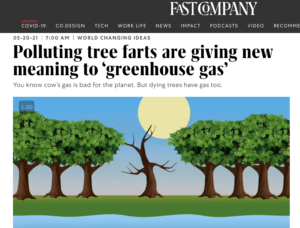Polluting tree farts are giving new meaning to ‘greenhouse gas’
You know cow’s gas is bad for the planet. But dying trees have gas too.
The study, recently published in the journal Biogeochemistry, looked at the emissions from “snags,” the dead trees in coastal wetlands known as ghost forests. Ghost forests are areas of woodland that rapidly transitioned into marshland, often because of rising sea levels, storm surges, and flooding, or even droughts, all caused by climate change. Those floods or rising seas leave behind saltwater-poisoned trees, ghostly gray trunks left jutting out of the wetlands—which, researchers found, fart out greenhouse gases.
The “tree fart” term started as a joke, but it’s an apt description, explains Melinda Martinez, lead author of the study and a graduate student at North Carolina State University studying forestry and environmental resources. “If you think about what a fart is in our bodies, it’s [gases] produced by microbial communities within our bodies, and so a fart is when something from one system is expelled into the atmosphere,” she says. “That’s essentially what’s happening within the snags themselves, too.”
Martinez wanted to look at these dead trees because most research on tree emissions has focused on live tree stems. She and her team thought these dead trees may be acting as “straws” for the gases produced in the soil. Soils in wetlands naturally produce CO2, methane, and nitrous oxide, and, it turns out, those gases travel up and out through the snags. These dead trees are more like filtered straws, the researchers found, because microbial communities within the snags can potentially change some of the methane—which is 40 times more potent than carbon dioxide—back to CO2.
To measure these emissions, Martinez wrapped a flexible chamber around the snags that created a seal around the tree. The gases accumulated inside the chamber, and a gas analyzer measured the concentrations over time. On the Albemarle-Pamlico Peninsula in North Carolina where the study was conducted, these tree farts could increase the region’s greenhouse gas emissions by 25%, because regional greenhouse gas budgets weren’t accounting for these dead trees’ emissions.
Just how much these tree farts are contributing to greenhouse gas levels will likely differ across species and regions. And what to do about these greenhouse-gas farting trees is a complicated question. It’s not as simple as chopping them down, Martinez says, because even as they die, they become new ecosystems for other species. She hopes her study is just the start of more research into ghost forests and their tree farts, and that experts start to take these emissions into account as this issue grows. “These ghost forests are not exclusive here in North Carolina,” she says. “It’s happening across the entire southeastern U.S., and we expect to see more of these forested wetlands shifting as the climate changes.”



